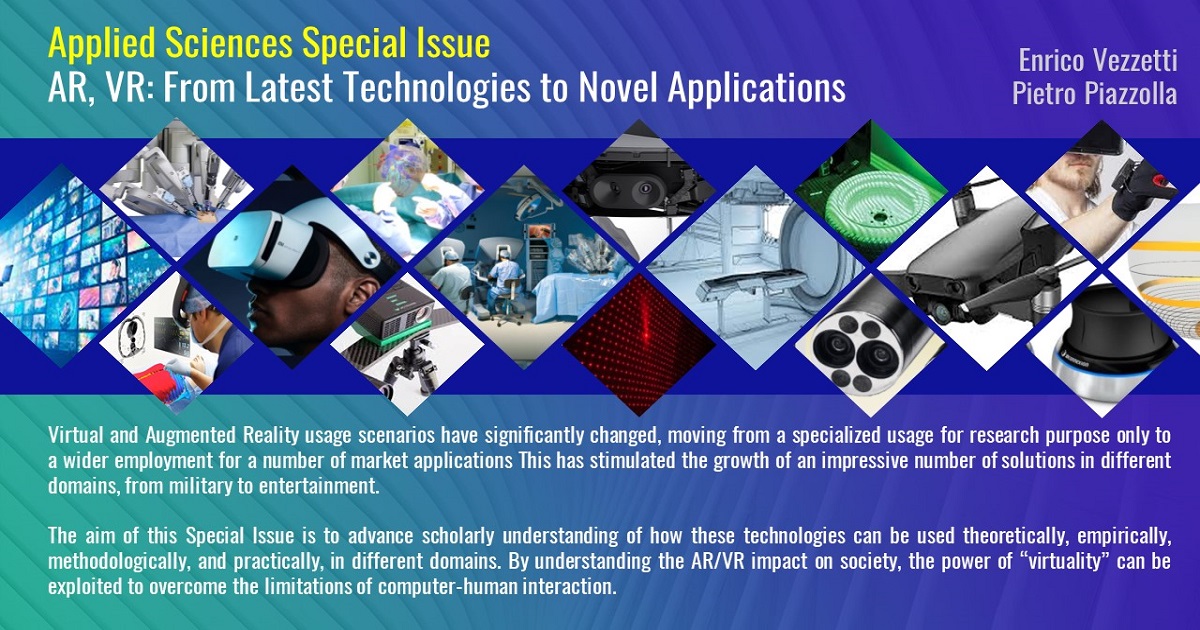AR, VR: From Latest Technologies to Novel Applications
A special issue of Applied Sciences (ISSN 2076-3417). This special issue belongs to the section "Computing and Artificial Intelligence".
Deadline for manuscript submissions: closed (20 May 2022) | Viewed by 128517

Special Issue Editors
Interests: product lifecycle management; product design and development; human–machine interaction; human–machine interface; human–computer interaction; computer-aided design; extended reality; augmented reality; virtual reality; artificial intelligence; behavioral analysis; digital therapies; minimally invasive surgery
Special Issues, Collections and Topics in MDPI journals
Special Issue Information
Dear Colleagues,
In recent years, virtual and augmented reality usage scenarios have significantly changed, moving from a specialized usage for research purpose only to a wider employment for a huge number of market applications and a significant number of users. This new situation has stimulated the growth of an impressive number of solutions in different domains, from military to entertainment.
Technological improvements have been registered, especially in smartphone devices, such as in camera performance and features, which have allowed the possibility of creating a tangible interaction between the real and the virtual domain that could be perceived as a “window on the real world”. For this reason, some important brands have significantly involved virtual and augmented reality in their efforts to support their commercial strategies, focusing the attention on “mobile augmented reality” (MAR).
Moreover, AR/VR flexibility could support its sinergic usage with other technologies representing an “integration platform” for technology empowerment, for instance, in machine and deeep learing (AI), which particularly in the computer vision domain may be able to provide very disruptive solutions, e.g., in the medical domain for disease diagnosis and for precise surgey assistance. Minimal invasive surgical (MIS) technologies are another viable example where the combination bewteen real-world data, live camera images in real-time, and virtual objects, artificially generated three-dimensional medical images coming from trans rectal ultrasound or computed tomography/MRI, could provide a tangible support to medical tasks. Moreover, due to the present COVID-19 situation that will force a significant percentage of the workforce to work from home multiple days a week by the end of 2021, it will be necessary to provide a change of perspective in many collaborative tasks, such as conference calls, which are often undermined by the lack of a direct personal presence, for instance, by exploiting AR/VR technologies to create a more socially conducive environment where everybody can improve “social interaction”. Thus, given the current surge of AR/VR applications and the new scenario provided by the pandemic situation due to COVID-19, it is important to synthesize the current knowledge about the interactions and impacts between society and AR/VR latests and novel applications.
The aim of this Special Issue is to advance scholarly understanding of how these technologies can be used theoretically, empirically, methodologically, and practically, to understand how society and AR/VR interact with and impact each other, also in relation to COVID-19, which has completely modified many usage scenarios, and in which the possibility to exploit the power of “virtuality” in its different points of view is becoming fundamental to overcoming the limitations of human interaction and support.
Prof. Dr. Enrico Vezzetti
Dr. Pietro Piazzolla
Guest Editors
Manuscript Submission Information
Manuscripts should be submitted online at www.mdpi.com by registering and logging in to this website. Once you are registered, click here to go to the submission form. Manuscripts can be submitted until the deadline. All submissions that pass pre-check are peer-reviewed. Accepted papers will be published continuously in the journal (as soon as accepted) and will be listed together on the special issue website. Research articles, review articles as well as short communications are invited. For planned papers, a title and short abstract (about 100 words) can be sent to the Editorial Office for announcement on this website.
Submitted manuscripts should not have been published previously, nor be under consideration for publication elsewhere (except conference proceedings papers). All manuscripts are thoroughly refereed through a single-blind peer-review process. A guide for authors and other relevant information for submission of manuscripts is available on the Instructions for Authors page. Applied Sciences is an international peer-reviewed open access semimonthly journal published by MDPI.
Please visit the Instructions for Authors page before submitting a manuscript. The Article Processing Charge (APC) for publication in this open access journal is 2400 CHF (Swiss Francs). Submitted papers should be well formatted and use good English. Authors may use MDPI's English editing service prior to publication or during author revisions.
Keywords
- Artificial Intelligence
- Machine Learning
- Virtual Reality
- Augmented Reality
- AR
- VR
- Human–machine interaction
- Education
- Health
- Services
- Transport
- Manufacturing
- Agriculture
- Tourism
- Culture
Benefits of Publishing in a Special Issue
- Ease of navigation: Grouping papers by topic helps scholars navigate broad scope journals more efficiently.
- Greater discoverability: Special Issues support the reach and impact of scientific research. Articles in Special Issues are more discoverable and cited more frequently.
- Expansion of research network: Special Issues facilitate connections among authors, fostering scientific collaborations.
- External promotion: Articles in Special Issues are often promoted through the journal's social media, increasing their visibility.
- e-Book format: Special Issues with more than 10 articles can be published as dedicated e-books, ensuring wide and rapid dissemination.
Further information on MDPI's Special Issue polices can be found here.






